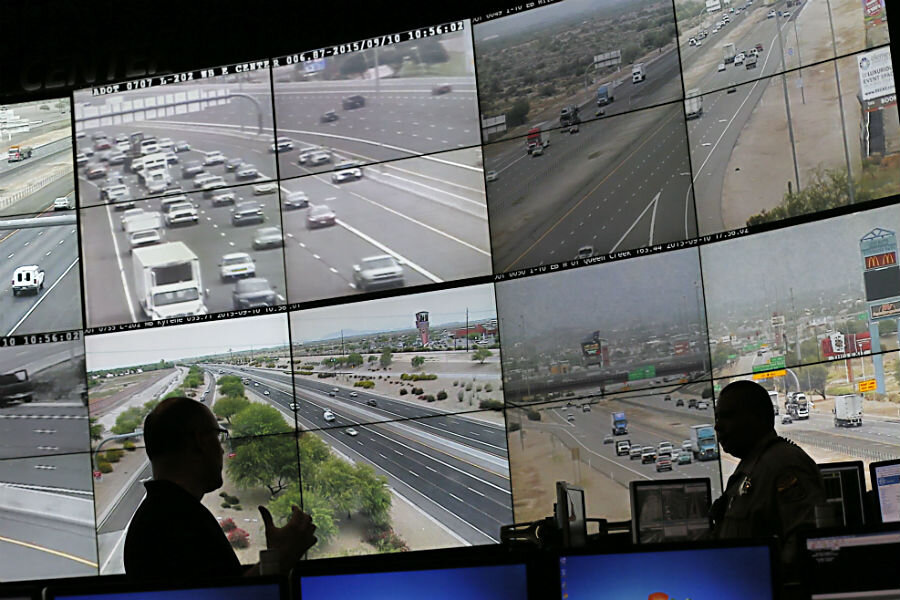Phoenix handled Arizona freeway shooting threat with post-9/11 poise
Loading...
| Atlanta
After a massive investigation, police in Phoenix, Ariz., announced on Saturday that they had captured a man they believed to be responsible for at least some of the 11 freeway shooting incidents over 12 days.
The arrest of 21-year-old Leslie Allen Merritt, Jr., by a Phoenix SWAT team at a suburban Walmart came as a relief to a city that had been riveted by the shootings, which had resulted in only one minor injury.
But the apparent culmination of the freeway drama also highlighted the extent to which Arizonans shrugged off panic by carrying on their normal – and sometimes dreary – commute, more alert than anxious, even in the face of an active shooting situation that Department of Public Safety Director Frank Milstead identified as an act of “domestic terrorism.”
Some people told local media they stayed off the freeways. But the vast majority of Arizonas who traveled a 10-mile stretch of Interstate 10 near Phoenix carried on their normal business.
The relatively non-sensationalistic media coverage that put the threat in perspective, a “massive” tracking effort by police, and a call-up of citizen-watch volunteers, all added to an example post-9/11 resolve to not be cowed by would-be terrorists. It also made what could have been a period of panic in Phoenix into an exercise in restraint and calm as police used a variety of techniques to pinpoint the suspected perpetrator.
“The freeway shootings riveted our attention … [b]ut they have not panicked anyone,” the Arizona Republic’s editorial board wrote. “In myriad ways, we have taken this threat in stride. [And] it is Valley citizens who should stand a bit taller for showing plenty of spine during these challenging weeks.”
To be sure, the incidents prompted speculation on what dark motives might drive someone to fire callously on random vehicles traveling on an interstate.
As yet, no motive has emerged for why the prime suspect, Mr. Merritt, allegedly targeted random motorists. His father, Leslie Merritt, Sr., told the Associated Press that his son is being scapegoated by police, adding that his son “has way too much value for human life to even take the slightest or remotest risk of actually injuring someone.”
The younger Merritt, a landscaper, faced a plethora of charges as he awaited arraignment on Saturday. They include criminal endangerment, assault, and unlawful discharge of a firearm.
Merritt reportedly told a judge Saturday, during his first court appearance, that authorities have "the wrong guy." The judge set bail at $1 million.
But whether Merritt is ultimately found guilty of shooting at motorists, forensic investigators note that such perpetrators are often motivated by anger, revenge, psychosis, and a longing to have a sense of power over other people.
“People are in fear of him,” Peter Vronsky, author of “Serial Killers: The Methods and Madness of Monsters,” told the Arizona Republic. “People are talking about him. Certainly, there’s a lot of satisfaction in that. He knows what tomorrow’s headlines will be.”
The US has seen several similar highway attackers in recent years. In 2002, John Muhammad and Lee Malvo struck fear into many Americans as they sniper-attacked and killed 10 people near the nation’s capital.
In 2004, police arrested Charles McCoy, Jr., after he killed one person during a shooting spree that involved at least a dozen separate incidents. And in 2014, three people were hurt amid a rash of over 20 gunfire incidents in Kansas City. Police finally arrested Mohammed Pedro Whitaker, who they claimed carried out at least a dozen of the attacks.
As with those attacks, the recent Phoenix shootings sparked copycat incidents. Last week, three teens were arrested for using a sling shot and gravel to shoot out a rear window of a car.
Police referred to the response to the Phoenix shootings as “massive.” It’s not clear exactly what put police on Merritt’s trail, but they tailed him Friday before arresting him around dinner time."I think the detectives really worked this," Arizona Department of Public Safety spokesman Bart Graves said on MSNBC on Saturday. He credited good police work and public tips for helping the investigation to come together over the past few days.
“I’d like to ask him what the [heck] he was thinking,” Robert McDonald, whose car was hit on Aug. 29, told the Republic in response to Merritt’s arrest.






